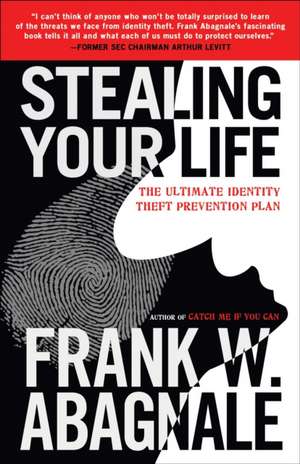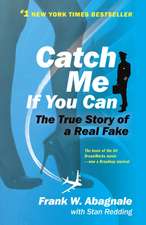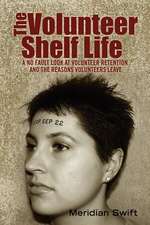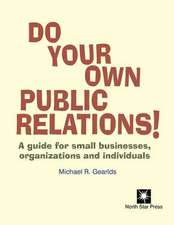Stealing Your Life: The Ultimate Identity Theft Prevention Plan
Autor Frank W. Abagnaleen Limba Engleză Paperback – 30 apr 2008
Consider these sobering facts:
*Six out of ten American companies and government agencies have already been hacked.
*An estimated 80 percent of birth certificate requests are fulfilled through the mail for people using only a name and a return address. So I could take your name and use my address, and get your birth certificate. From there I’m off to the races.
*Americans write 39 billion checks a year, and half of these folks never reconcile their bank statements.
*A Social Security number costs $49 on the black market. A driver’s license goes for $90. A birth certificate will set you back $79.
When Frank Abagnale trains law enforcement officers around the country about identity theft, he asks officers for their names and addresses and nothing more. In a matter of hours he can obtain everything he would need to steal their lives: Social Security numbers, dates of birth, current salaries, checking account numbers, the names of everyone in their families, and more. This illustrates how easy it is for anyone from anywhere in the world to assume our identities and in a matter of hours devastate our lives in ways that can take years to recover from. Considering that a fresh victim is hit every four seconds, Stealing Your Life is the reference everyone needs by an unsurpassed authority on the latest identity theft schemes.
Abagnale offers dozens of concrete steps to transform anyone from an easy mark into a hard case that criminals are likely to bypass:
• Don’t allow your kids to use the computer on which you do online banking and store financial records (children are apt to download games and attachments that host damaging viruses or attract spyware).
• Beware of offers that appeal to greed or fear in exchange for personal data.
• Monitor your credit report regularly and know if anyone’s been “knocking on your door.”
• Read privacy statements carefully and choose to opt out of sharing information whenever possible.
Brimming with anecdotes of creative criminality that are as entertaining as they are enlightening, Stealing Your Life is the practical way to shield yourself from one of today’s most nefarious and common crimes.
Preț: 105.63 lei
Nou
Puncte Express: 158
Preț estimativ în valută:
20.21€ • 21.13$ • 17.08£
20.21€ • 21.13$ • 17.08£
Carte disponibilă
Livrare economică 13-27 februarie
Preluare comenzi: 021 569.72.76
Specificații
ISBN-13: 9780767925877
ISBN-10: 0767925874
Pagini: 242
Dimensiuni: 135 x 203 x 20 mm
Greutate: 0.21 kg
Editura: BROADWAY BOOKS
ISBN-10: 0767925874
Pagini: 242
Dimensiuni: 135 x 203 x 20 mm
Greutate: 0.21 kg
Editura: BROADWAY BOOKS
Notă biografică
When I was passing phony checks in other people’s names thirty years ago, it took me weeks and a million-dollar Heidelberg printing press to create and cash a realistic-looking check. Today criminals do it in an instant on a $500 computer, with no witnesses to pick them out of a lineup, because they’re doing it from an armchair in China, Russia, or Nigeria, a continent away. In recent years identity theft has become the very monster I feared it would become and wrote about in the l980s.
FRANK W. ABAGNALE is the author of the bestselling memoir Catch Me If You Can and The Art of the Steal. He works closely with the FBI and corporations around the world as an expert on counterfeiting and secure documents. He lives in the Midwest with his wife and is the father of three sons.
FRANK W. ABAGNALE is the author of the bestselling memoir Catch Me If You Can and The Art of the Steal. He works closely with the FBI and corporations around the world as an expert on counterfeiting and secure documents. He lives in the Midwest with his wife and is the father of three sons.
Extras
1
The Sweetest Con of All
Anthony Dwight Stone was perfectly happy being Anthony Dwight Stone, for all of his first thirty–one years. This sense of contentment continued right up until the day, a few years ago, when he learned that Thomas Earl Batts had decided to also become Anthony Dwight Stone, and the world got a little too crowded.
The real Anthony Stone was driving through Nash County, North Carolina, when he was stopped for speeding. When his license was inspected, the police gave him the news that he was wanted for drug possession. Geez, he said, they had to be kidding. They weren’t, and he got tossed in jail for the night. Then the police showed him a picture that was supposedly him. It was of a man with his hair coiled in braids and a stomach that ran on forever who easily weighed three hundred pounds; Stone boasted curly hair and weighed 170, tops. He recognized the man right away. That was Thomas Earl Batts, his sister’s boyfriend.
Being his sister’s boyfriend had made it pretty easy for Batts to gather the necessary information—Social Security number and a few other key facts—and slip into Anthony Stone’s identity. And it certainly changed Anthony Stone’s view of what sisters are for.
As it turned out, Stone said, Batts had quietly appropriated Stone’s identity some ten years earlier and had been living right alongside him, using credit cards in Stone’s name to buy various necessary and unnecessary merchandise. He had gone and gotten a loan in Stone’s name to purchase a house. And out of force of bad habit, he had built up a tidy little rap sheet.
None of this was a good thing for Anthony Stone. Batts, for instance, didn’t bother to keep current with his credit. But then, what did he care? He wasn’t really Anthony Stone. And so the real Anthony Stone found himself branded as a congenital loser. He had an impossible time getting credit—any credit. “Doors of all kind were shut in my face,” he said. He’d apply for a job and would be promptly turned down; once he found work and, after a lagging credit check, was whisked right out of a company car.
When he belatedly got around to applying to college, he got nothing but rejections, since his sketchy credit and criminal misdeeds weren’t quite what the admissions people had in mind for their incoming class. It didn’t seem to matter that it wasn't his credit record or his criminal record. “I’d get into my apartment and get a notice six or seven times that I was evicted,” he said. “I felt like life had stopped.”
It took years to untangle the mess. And Anthony Stone had to wonder, what if it happened again? Which is why he went to court and changed his name to Stone Tyler, essentially ceding his old identity to the dustbin. At the same time, he applied for a new Social Security number. He was laughed at and told it couldn’t be done, but he ultimately did get it done. “Basically, you can’t get your Social Security number changed unless it’s life–threatening,” he said.
Tyler, who lives in Durham, North Carolina, at last got into college and found a job with Blue Cross Blue Shield. Batts served a brief jail sentence, and that was it. For many people, the metamorphosis that Stone Tyler chose—new name, new Social Security number—might seem like an extreme response to an admittedly awful situation, and I wouldn’t recommend going quite that far. But from where he sat he saw no choice. This con was just too much for him.
His rude ordeal taught this young man, who had been leading an unremarkable life in North Carolina, that he lived in a new world in which all identities are at risk and, in essence, are in play.
I know cons, and right away I saw that this one was going to be the sweetest of all. For the past thirty–two years, ever since forsaking my foolish teenage infatuation with perpetrating swindles, I’ve been a professional expert in how to prevent fraud. Nearly twenty years ago, as I was busy trying to help banks and businesses stop the spiraling increase in rubber checks and wily embezzlement schemes, it became obvious to me that a brand–new fraud, still in its formative stages and without even a clarifying name, was destined to overwhelm all the others as the clear crime of choice. In fact, it was a crook’s dream come true, the sort of surefire caper that makes a career criminal glad he ignored his mother’s advice and picked the wrong side of the law.
Years before, I would never have guessed that it could even be invented, for it was the most incredible but also the simplest crime ever perpetrated. And if I manage to live forty more years, it will remain the simplest crime ever committed—and the most profitable.
This festering crime is what we now know as identity theft, the wholesale lifting of someone’s identity for illicit gain. It’s stealing that identity, then using it to access a person’s bank account, their personal information, and their personal finances. It’s becoming someone else for the bucks.
Why did I think it contained such enormous promise for thieves? First of all, it is elementary to pull off. If you have my name, my date of birth, and my Social Security number, that’s pretty much all you need in order to become me. It takes very little investment capital. A phone and a cheap computer will get you started. If you want to write phony checks, you’ll need a few vital tools like a blow–dryer, cake pans, and a common household chemical. You can pick them up at your nearest discount drugstore, and no one will be the wiser.
Then, the rewards are enormous. Identity theft will afford you access not only to someone’s wallet and bank account but to his very life and character, his entire ability to borrow and spend. Are you worried about the law? No need. Technology has made identity theft easy to execute behind the shadowy cloak of a computer keyboard. You don’t even have to be in the same city, or country, as your victim. You can steal someone’s identity without being able to speak his language or pronounce her name.
Moreover, law enforcement cares less about identity theft than it does about double–parked cars and public loiterers. Your chances of getting caught are minuscule. But even if you do get caught, you are unlikely to spend a single night in jail. Swiping a kid’s bike might have graver consequences.
When I ran all these things through my mind, they unnerved me to no end. And my long–dormant criminal instincts stirred a little and made me think, Why didn’t they invent this con back when I could have used it?
When I was passing phony checks in other people’s names more than thirty years ago, for example, it took me three months and a million–dollar Heidelberg printing press to create and cash a realistic–looking product. Today criminals do it in an instant on a $500 computer, with no witnesses to pick them out in a lineup, because they’re doing it from an armchair in China or Russia, a continent away. And checks are simply one piece of an identity thief’s arsenal.
In recent years identity theft has become the very monster I feared it would become. It’s a crime so versatile that the list of potential targets is endless. Who’s at risk? Anyone who has a credit card or a bank account, or who pays a bill. Anyone who has a mortgage, a car loan, or a debit card. Anyone who has a driver’s license, a Social Security number, or a job. Anyone who has phone service or health insurance. Anyone who goes on the Internet.
Even somebody who’s always watching his back, like me. People of all ages, all races, all incomes, and both sexes. A thirty–five–year–old New York busboy had the hubris to choose names off the Forbes 400 list, including Ross Perot, Oprah Winfrey, Michael Bloomberg, and Ted Turner, gleaned additional information on them from the Internet, and became them. Robert De Niro’s identity was assumed by his movie double. Tiger Woods was victimized by a California man who rented a moving truck and a storage locker in his name. In Chandler, Arizona, the identity of the retired police chief was taken over by a woman who loaded up at Wal–Mart and Sam’s Club stores. Twin brothers were kicked off the popular American Idol show after police said they had bought a car using the stolen identities of two unwitting fans.
In other words, anyone who’s alive is a potential victim. Actually, I stand corrected—even the dead can become targets of this insidious crime. You can have lived your life, then be resting eternally six feet under—and you’re still not protected from the long reach of identity thieves. Scam artists have no compunction. After all, the dead rarely complain.
These days you can’t go to a party or have lunch with three or four people without someone in that group mentioning that he got a phony e–mail, or that his credit card was compromised—that somehow someone snatched his identity. Identity theft is the fastest–growing criminal activity in the country (and it’s doing awfully well abroad). And it could be coming soon to a bank account near you.
Every Four Seconds
Accurate statistics on identity theft are tricky to come by, because it remains an underdocumented crime. Many people and businesses don’t report incidents to the police, and a startling number of people don't even know their identities have been stolen. The reported numbers, though, are shocking.
At the time when I wrote my last book, The Art of the Steal, in 2001, there were about 750,000 documented victims of identity theft, and losses to banks and credit card companies amounted to $5 billion. That’s not chicken feed, but in 2003 the Federal Trade Commission released the most exhaustive government study to date of identity theft, estimating that there had been 27.3 million victims in the prior five years. In 2004 alone, around 10 million consumers suffered from some variation of identity theft, and losses exceeded $54 billion. In 2005 the FTC was swamped with five thousand calls a week relating to the problem, more than they got on any other issue and triple what they had received just five years before.
When a major insurance company recently polled a sizable sampling of its policyholders on their biggest fears, the number–one response was their fear of losing all their assets through bad stock market and other investments. Number two was their fear of identity theft. Throughout the country people go out of their way to put multiple locks on their doors and install costly silent alarm systems. Well, in a given year, about 2.6 percent of Americans have their homes burglarized, but about 4.3 percent of them have their identities stolen. In 2005 it’s believed that an identity was stolen every four seconds.
The crime has universal appeal to criminals, and it’s happening all over the world. A recent survey conducted in New Zealand by Baycorp Advantage found that one in ten of the 450 Kiwis questioned said that they had been the victim of identity theft.
The crime has become so mainstream that comedians have begun joking about it, always a tip–off that it’s time to worry. Andy Borowitz, a humor columnist, quipped recently that a thief who rounded up a half–million identities returned all but four of them because the other 499,996 were “totally worthless.” Identity thieves, he said, were getting awfully sick of this, feeling it only fair that financial institutions clearly flag deadbeat identities so that crooks don’t have to waste their valuable time.
I’ll Tell You Twenty–two Things Overnight
In my entire career I have never encountered a crime as easy to pull off as identity theft. The main reason is that so much personal information is widely and publicly available, there for anyone to take. Once upon a time criminals used to have to really work to make an illegal living. Back when I was passing bad checks, if you wanted to lift information on someone’s identity, you had to penetrate so much bureaucracy that it almost wasn’t worth the headache. You had to go down to the county records department and try to cadge information, or try to get at boating records and mortgage information by cajoling low–level civil service workers. It could be done, but it took know–how and talent, plus you had to do it in person, producing witnesses. Now rank amateurs can do it, with technology’s helping hand. An identity thief can acquire everything needed to steal your life by going online for less than thirty minutes. If he’s in a big rush and has a high–speed Internet hookup, fifteen might suffice. Getting someone’s supposedly secure information is no harder than downloading a Paris Hilton video.
I regularly teach agents at the FBI Academy, and one little demonstration I do is to ask one of my students for his address. Nothing more, not even his name. By the following morning I’m able to hand over to him twenty–two pieces of so–called “private” information about him, including his Social Security number, birth date, salary, current bank and account numbers, mother’s maiden name, children’s names, spouse’s name and Social Security number, and neighbors. I can even reveal who lives with him in his house but isn’t related to him. And I don’t even have to do something as dramatic as hack into a bank database. All this information is readily available from publicly accessible sources on the Internet, and you or Joe Criminal can get it as easily as I did. Imagine how much I could have found out about the guy if I had decided to break the law!
Just this past year a friend of mine had his birthday in June, and I wanted to send him a card, but I couldn’t remember the exact date. So I logged on to the Web and went to the Texas Public Health Records, because I knew he had been born in Texas, and typed in his name. Up came the city and county he was born in, as well as his mother’s maiden name, his date of birth, and on and on, all the information right there online for free.
Consider these sobering facts:
• Six out of ten American companies and government agencies have already been hacked.
• An estimated 80 percent of birth certificate requests are fulfilled through the mail for people using only a name and a return address. So I could take your name, use my address, and get your birth certificate. From there I’m off to the races.
• Americans write 39 billion checks a year, and half of these folks never reconcile their bank statements.
• A Social Security number costs $49 on the black market. A driver’s license goes for $90. A birth certificate will set you back $79.
In today’s hotly competitive financial marketplace, speed is of the essence. Thieves love fast credit approval, because haste is the enemy of accuracy. Credit card issuers, for their part, can be very sloppy in doling out cards, failing to match Social Security numbers and dates of birth and otherwise failing to take basic precautions in their eagerness to get cards in circulation. Issuers say their screening is tighter than ever, but dead people, one–year–old babies, and dogs of varying ages still find themselves offered preapproved cards. (I imagine a few turtles and some parakeets have gotten them as well.) A Livermore, California, man signed up for an e–mail account in his dog’s name, expanding it to Clifford J. Dog. Sure enough, in short order Clifford got a preapproved credit card application. As a lark, the owner filled it out. Pugsy Malone was listed as the mother’s name. For the Social Security number, the owner chose 000-00-0000. Then he wrote that this was for a dog, please don’t send a card. Naturally, the card came.
In fact, it’s now child’s play to assume someone’s identity. Suppose you go to the grocery store and write a check for $52. The check bears your full name and address and maybe your phone number to boot. It also has the full name and address of the bank where the check is drawn and your account number. Maybe the clerk asks to see your driver’s license. The clerk might jot down the license number (in nine states, that could still be your Social Security number) and even your date of birth.
Hundreds of people, from the grocery store clerk to check–clearing house employees, will see this check. Then it goes back to the payee bank. If you don’t get your checks in your statement, they go to a company that shreds them—and even there they can be copied before being shredded. And that’s just one way thieves can get virtually all the vital information they need.
To prove a point a few years ago, the California-based Foundation for Taxpayer and Consumer Rights went on the Internet and bought the Social Security numbers and home addresses of the CIA director, the attorney general, and the FTC chairman. It cost them $26. Sounds like a steal to me.
From the Hardcover edition.
The Sweetest Con of All
Anthony Dwight Stone was perfectly happy being Anthony Dwight Stone, for all of his first thirty–one years. This sense of contentment continued right up until the day, a few years ago, when he learned that Thomas Earl Batts had decided to also become Anthony Dwight Stone, and the world got a little too crowded.
The real Anthony Stone was driving through Nash County, North Carolina, when he was stopped for speeding. When his license was inspected, the police gave him the news that he was wanted for drug possession. Geez, he said, they had to be kidding. They weren’t, and he got tossed in jail for the night. Then the police showed him a picture that was supposedly him. It was of a man with his hair coiled in braids and a stomach that ran on forever who easily weighed three hundred pounds; Stone boasted curly hair and weighed 170, tops. He recognized the man right away. That was Thomas Earl Batts, his sister’s boyfriend.
Being his sister’s boyfriend had made it pretty easy for Batts to gather the necessary information—Social Security number and a few other key facts—and slip into Anthony Stone’s identity. And it certainly changed Anthony Stone’s view of what sisters are for.
As it turned out, Stone said, Batts had quietly appropriated Stone’s identity some ten years earlier and had been living right alongside him, using credit cards in Stone’s name to buy various necessary and unnecessary merchandise. He had gone and gotten a loan in Stone’s name to purchase a house. And out of force of bad habit, he had built up a tidy little rap sheet.
None of this was a good thing for Anthony Stone. Batts, for instance, didn’t bother to keep current with his credit. But then, what did he care? He wasn’t really Anthony Stone. And so the real Anthony Stone found himself branded as a congenital loser. He had an impossible time getting credit—any credit. “Doors of all kind were shut in my face,” he said. He’d apply for a job and would be promptly turned down; once he found work and, after a lagging credit check, was whisked right out of a company car.
When he belatedly got around to applying to college, he got nothing but rejections, since his sketchy credit and criminal misdeeds weren’t quite what the admissions people had in mind for their incoming class. It didn’t seem to matter that it wasn't his credit record or his criminal record. “I’d get into my apartment and get a notice six or seven times that I was evicted,” he said. “I felt like life had stopped.”
It took years to untangle the mess. And Anthony Stone had to wonder, what if it happened again? Which is why he went to court and changed his name to Stone Tyler, essentially ceding his old identity to the dustbin. At the same time, he applied for a new Social Security number. He was laughed at and told it couldn’t be done, but he ultimately did get it done. “Basically, you can’t get your Social Security number changed unless it’s life–threatening,” he said.
Tyler, who lives in Durham, North Carolina, at last got into college and found a job with Blue Cross Blue Shield. Batts served a brief jail sentence, and that was it. For many people, the metamorphosis that Stone Tyler chose—new name, new Social Security number—might seem like an extreme response to an admittedly awful situation, and I wouldn’t recommend going quite that far. But from where he sat he saw no choice. This con was just too much for him.
His rude ordeal taught this young man, who had been leading an unremarkable life in North Carolina, that he lived in a new world in which all identities are at risk and, in essence, are in play.
I know cons, and right away I saw that this one was going to be the sweetest of all. For the past thirty–two years, ever since forsaking my foolish teenage infatuation with perpetrating swindles, I’ve been a professional expert in how to prevent fraud. Nearly twenty years ago, as I was busy trying to help banks and businesses stop the spiraling increase in rubber checks and wily embezzlement schemes, it became obvious to me that a brand–new fraud, still in its formative stages and without even a clarifying name, was destined to overwhelm all the others as the clear crime of choice. In fact, it was a crook’s dream come true, the sort of surefire caper that makes a career criminal glad he ignored his mother’s advice and picked the wrong side of the law.
Years before, I would never have guessed that it could even be invented, for it was the most incredible but also the simplest crime ever perpetrated. And if I manage to live forty more years, it will remain the simplest crime ever committed—and the most profitable.
This festering crime is what we now know as identity theft, the wholesale lifting of someone’s identity for illicit gain. It’s stealing that identity, then using it to access a person’s bank account, their personal information, and their personal finances. It’s becoming someone else for the bucks.
Why did I think it contained such enormous promise for thieves? First of all, it is elementary to pull off. If you have my name, my date of birth, and my Social Security number, that’s pretty much all you need in order to become me. It takes very little investment capital. A phone and a cheap computer will get you started. If you want to write phony checks, you’ll need a few vital tools like a blow–dryer, cake pans, and a common household chemical. You can pick them up at your nearest discount drugstore, and no one will be the wiser.
Then, the rewards are enormous. Identity theft will afford you access not only to someone’s wallet and bank account but to his very life and character, his entire ability to borrow and spend. Are you worried about the law? No need. Technology has made identity theft easy to execute behind the shadowy cloak of a computer keyboard. You don’t even have to be in the same city, or country, as your victim. You can steal someone’s identity without being able to speak his language or pronounce her name.
Moreover, law enforcement cares less about identity theft than it does about double–parked cars and public loiterers. Your chances of getting caught are minuscule. But even if you do get caught, you are unlikely to spend a single night in jail. Swiping a kid’s bike might have graver consequences.
When I ran all these things through my mind, they unnerved me to no end. And my long–dormant criminal instincts stirred a little and made me think, Why didn’t they invent this con back when I could have used it?
When I was passing phony checks in other people’s names more than thirty years ago, for example, it took me three months and a million–dollar Heidelberg printing press to create and cash a realistic–looking product. Today criminals do it in an instant on a $500 computer, with no witnesses to pick them out in a lineup, because they’re doing it from an armchair in China or Russia, a continent away. And checks are simply one piece of an identity thief’s arsenal.
In recent years identity theft has become the very monster I feared it would become. It’s a crime so versatile that the list of potential targets is endless. Who’s at risk? Anyone who has a credit card or a bank account, or who pays a bill. Anyone who has a mortgage, a car loan, or a debit card. Anyone who has a driver’s license, a Social Security number, or a job. Anyone who has phone service or health insurance. Anyone who goes on the Internet.
Even somebody who’s always watching his back, like me. People of all ages, all races, all incomes, and both sexes. A thirty–five–year–old New York busboy had the hubris to choose names off the Forbes 400 list, including Ross Perot, Oprah Winfrey, Michael Bloomberg, and Ted Turner, gleaned additional information on them from the Internet, and became them. Robert De Niro’s identity was assumed by his movie double. Tiger Woods was victimized by a California man who rented a moving truck and a storage locker in his name. In Chandler, Arizona, the identity of the retired police chief was taken over by a woman who loaded up at Wal–Mart and Sam’s Club stores. Twin brothers were kicked off the popular American Idol show after police said they had bought a car using the stolen identities of two unwitting fans.
In other words, anyone who’s alive is a potential victim. Actually, I stand corrected—even the dead can become targets of this insidious crime. You can have lived your life, then be resting eternally six feet under—and you’re still not protected from the long reach of identity thieves. Scam artists have no compunction. After all, the dead rarely complain.
These days you can’t go to a party or have lunch with three or four people without someone in that group mentioning that he got a phony e–mail, or that his credit card was compromised—that somehow someone snatched his identity. Identity theft is the fastest–growing criminal activity in the country (and it’s doing awfully well abroad). And it could be coming soon to a bank account near you.
Every Four Seconds
Accurate statistics on identity theft are tricky to come by, because it remains an underdocumented crime. Many people and businesses don’t report incidents to the police, and a startling number of people don't even know their identities have been stolen. The reported numbers, though, are shocking.
At the time when I wrote my last book, The Art of the Steal, in 2001, there were about 750,000 documented victims of identity theft, and losses to banks and credit card companies amounted to $5 billion. That’s not chicken feed, but in 2003 the Federal Trade Commission released the most exhaustive government study to date of identity theft, estimating that there had been 27.3 million victims in the prior five years. In 2004 alone, around 10 million consumers suffered from some variation of identity theft, and losses exceeded $54 billion. In 2005 the FTC was swamped with five thousand calls a week relating to the problem, more than they got on any other issue and triple what they had received just five years before.
When a major insurance company recently polled a sizable sampling of its policyholders on their biggest fears, the number–one response was their fear of losing all their assets through bad stock market and other investments. Number two was their fear of identity theft. Throughout the country people go out of their way to put multiple locks on their doors and install costly silent alarm systems. Well, in a given year, about 2.6 percent of Americans have their homes burglarized, but about 4.3 percent of them have their identities stolen. In 2005 it’s believed that an identity was stolen every four seconds.
The crime has universal appeal to criminals, and it’s happening all over the world. A recent survey conducted in New Zealand by Baycorp Advantage found that one in ten of the 450 Kiwis questioned said that they had been the victim of identity theft.
The crime has become so mainstream that comedians have begun joking about it, always a tip–off that it’s time to worry. Andy Borowitz, a humor columnist, quipped recently that a thief who rounded up a half–million identities returned all but four of them because the other 499,996 were “totally worthless.” Identity thieves, he said, were getting awfully sick of this, feeling it only fair that financial institutions clearly flag deadbeat identities so that crooks don’t have to waste their valuable time.
I’ll Tell You Twenty–two Things Overnight
In my entire career I have never encountered a crime as easy to pull off as identity theft. The main reason is that so much personal information is widely and publicly available, there for anyone to take. Once upon a time criminals used to have to really work to make an illegal living. Back when I was passing bad checks, if you wanted to lift information on someone’s identity, you had to penetrate so much bureaucracy that it almost wasn’t worth the headache. You had to go down to the county records department and try to cadge information, or try to get at boating records and mortgage information by cajoling low–level civil service workers. It could be done, but it took know–how and talent, plus you had to do it in person, producing witnesses. Now rank amateurs can do it, with technology’s helping hand. An identity thief can acquire everything needed to steal your life by going online for less than thirty minutes. If he’s in a big rush and has a high–speed Internet hookup, fifteen might suffice. Getting someone’s supposedly secure information is no harder than downloading a Paris Hilton video.
I regularly teach agents at the FBI Academy, and one little demonstration I do is to ask one of my students for his address. Nothing more, not even his name. By the following morning I’m able to hand over to him twenty–two pieces of so–called “private” information about him, including his Social Security number, birth date, salary, current bank and account numbers, mother’s maiden name, children’s names, spouse’s name and Social Security number, and neighbors. I can even reveal who lives with him in his house but isn’t related to him. And I don’t even have to do something as dramatic as hack into a bank database. All this information is readily available from publicly accessible sources on the Internet, and you or Joe Criminal can get it as easily as I did. Imagine how much I could have found out about the guy if I had decided to break the law!
Just this past year a friend of mine had his birthday in June, and I wanted to send him a card, but I couldn’t remember the exact date. So I logged on to the Web and went to the Texas Public Health Records, because I knew he had been born in Texas, and typed in his name. Up came the city and county he was born in, as well as his mother’s maiden name, his date of birth, and on and on, all the information right there online for free.
Consider these sobering facts:
• Six out of ten American companies and government agencies have already been hacked.
• An estimated 80 percent of birth certificate requests are fulfilled through the mail for people using only a name and a return address. So I could take your name, use my address, and get your birth certificate. From there I’m off to the races.
• Americans write 39 billion checks a year, and half of these folks never reconcile their bank statements.
• A Social Security number costs $49 on the black market. A driver’s license goes for $90. A birth certificate will set you back $79.
In today’s hotly competitive financial marketplace, speed is of the essence. Thieves love fast credit approval, because haste is the enemy of accuracy. Credit card issuers, for their part, can be very sloppy in doling out cards, failing to match Social Security numbers and dates of birth and otherwise failing to take basic precautions in their eagerness to get cards in circulation. Issuers say their screening is tighter than ever, but dead people, one–year–old babies, and dogs of varying ages still find themselves offered preapproved cards. (I imagine a few turtles and some parakeets have gotten them as well.) A Livermore, California, man signed up for an e–mail account in his dog’s name, expanding it to Clifford J. Dog. Sure enough, in short order Clifford got a preapproved credit card application. As a lark, the owner filled it out. Pugsy Malone was listed as the mother’s name. For the Social Security number, the owner chose 000-00-0000. Then he wrote that this was for a dog, please don’t send a card. Naturally, the card came.
In fact, it’s now child’s play to assume someone’s identity. Suppose you go to the grocery store and write a check for $52. The check bears your full name and address and maybe your phone number to boot. It also has the full name and address of the bank where the check is drawn and your account number. Maybe the clerk asks to see your driver’s license. The clerk might jot down the license number (in nine states, that could still be your Social Security number) and even your date of birth.
Hundreds of people, from the grocery store clerk to check–clearing house employees, will see this check. Then it goes back to the payee bank. If you don’t get your checks in your statement, they go to a company that shreds them—and even there they can be copied before being shredded. And that’s just one way thieves can get virtually all the vital information they need.
To prove a point a few years ago, the California-based Foundation for Taxpayer and Consumer Rights went on the Internet and bought the Social Security numbers and home addresses of the CIA director, the attorney general, and the FTC chairman. It cost them $26. Sounds like a steal to me.
From the Hardcover edition.
Recenzii
“Offering spine-tingling terror for anyone who has a Social Security number and birth date, this heart-pounding guide drives home the point that identity theft can come from any direction at any time to anyone.” —Publisher’s Weekly
“Stealing Your Life provides powerful strategies for prevention, and is filled with informative examples of true-life fraud cases. [Abagnale] shows how to recognize the tell-tale signs of fraud, identifies likely culprits, how they get the data they need, and how they ultimately make a profit.” —Tulsa World
“Nobody knows the ins and outs of identity fraud better than Frank Abagnale.” –Inc. magazine
“Stealing Your Life provides powerful strategies for prevention, and is filled with informative examples of true-life fraud cases. [Abagnale] shows how to recognize the tell-tale signs of fraud, identifies likely culprits, how they get the data they need, and how they ultimately make a profit.” —Tulsa World
“Nobody knows the ins and outs of identity fraud better than Frank Abagnale.” –Inc. magazine
Descriere
The charismatic forger immortalized in the film "Catch Me If You Can" exposes the astonishing tactics of today's identity theft criminals and offers powerful strategies to thwart them, based on his second career as an acclaimed fraud-fighting consultant.




















